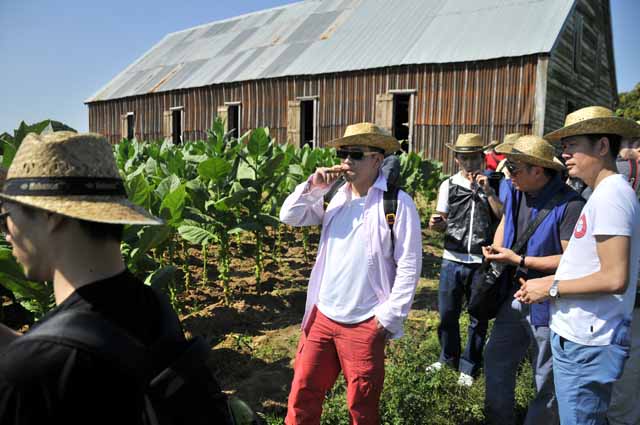A Journey to the Land of the World’s Best Tobacco

Over a hundred kilometers were left behind and guests attending the 16th Habano Festival were just about to live one of the most exciting and customary experiences of all: a grand tour around the finest tobacco plantations in the world: Vuelta Abajo in Pinar del Rio.
Over there, like in no other place across Cuba or around the globe, peculiar characteristics come together: soils, climate, a deep-rooted culture in plantation management and centuries-old traditions of tobacco planters, men who know the secrets to the fields and tobacco.
Cameras in hand, wearing broad hats to block the sweltering sun and teeming with curiosity, attendees to the Habano Festival went to meet humble, weather-beaten man and women who are benchmarks of skillfulness and experience in this region.
While imbued in the collection and piercing of leaves, the tobacco growers told guests that each and every plant must be visited some 150 times for a number of reasons during the growing and harvesting period. There are also two ways of growing tobacco: sunlit and sun-shaded, with planters using thin cheesecloth to protect the plants from the sun and prevent the leaves from turning coarse, thick or fibrous.
Fields of sunlit tobacco engulf most of the surface and chip in their leaves for the filler of habanos and the binder that wraps up that initial blend. For their part, the sun-shaded plantations provide the wrappers, very delicate, thin and smooth-textured leaves that give habanos their fancy finishing outfit.
“This is like a bug that drills inside of you. I can’t picture myself doing something else. I think neither me nor my family could ever break free from this passion,” says seasoned tobacco planter Leandro Gomez Benitez, 82, who has devoted many decades to the growing, managing and harvesting of tobacco, together with his wife and a granddaughter.
Gladys Esther Milian Diaz, a 70-year-old, dry-behind-the-ears planter, today spends time piercing leaves together alongside wooden rods. She speaks proudly of her college degree and of the time when she decided to return to the plantations following her retirement.
Inside the curing barn boasting the traditional sepia-hued leaves and characteristic scent, Gladys admits that regardless of her age she’s able to do more than 60 rods a day, every one of them with dozens of leaf pairs knit to it.
In her view, the secret to tobacco quality is owed not only to the exceptional soil and weather conditions in the region, but also to “the love and dedication, the responsibility, the care and the heed we pay to the plantations. As Jose Marti used to say, ‘a land is good when man is good’.”
Delegates attending the 16th Habano Festival also had the chance to take a closer look at such tasks as wick removal and leaf selection. And to top it all off in this wonderful afternoon, guests reveled in a Cuban-style lunch right at the base of the emblematic Valley of Prehistory.










